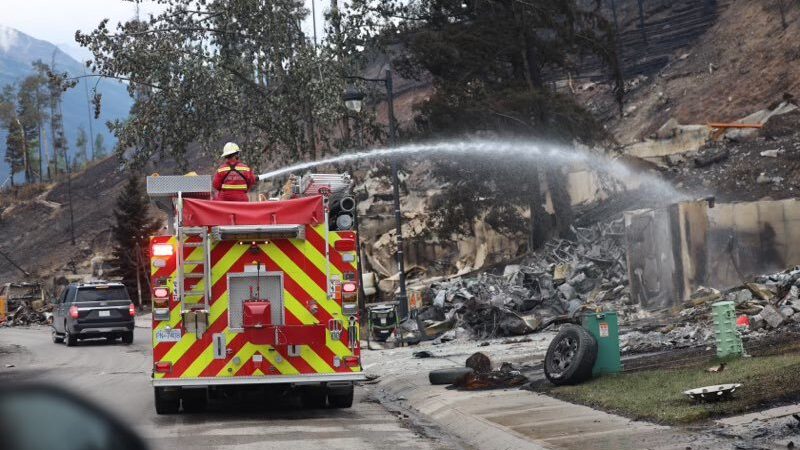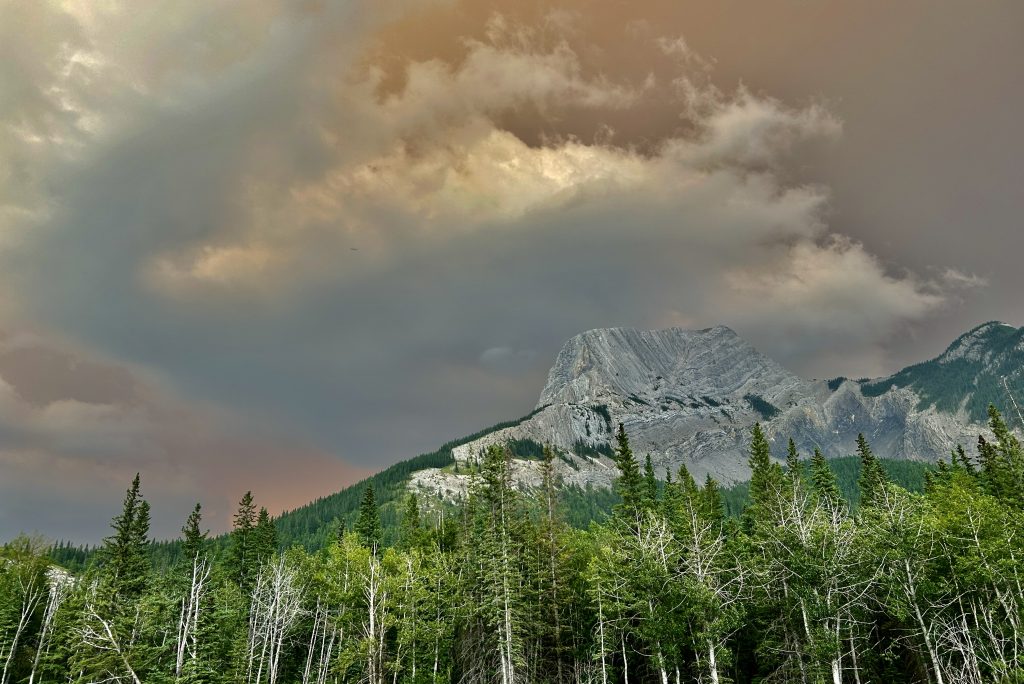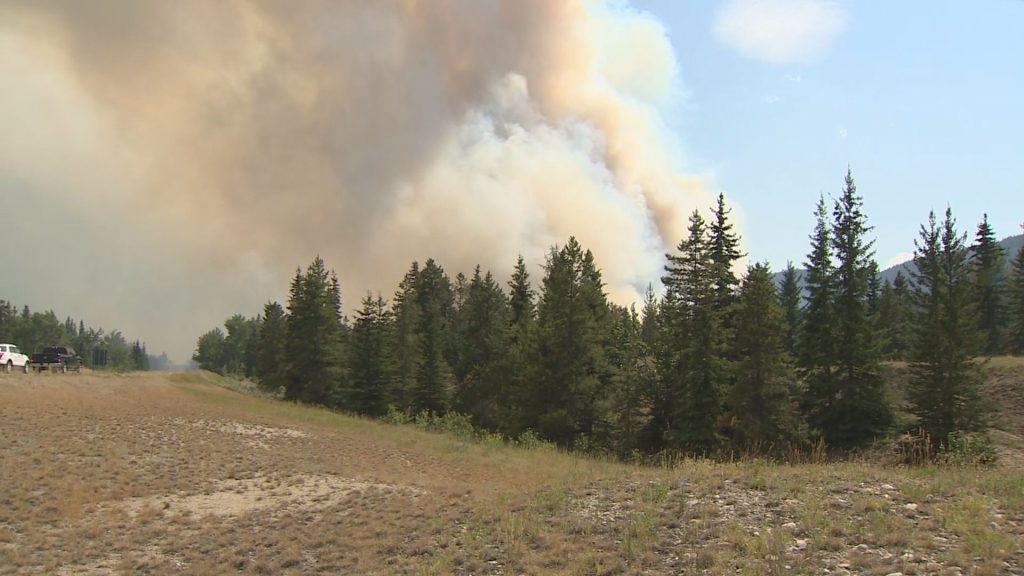Alberta government announces new rules for renewables projects as moratorium ends
Posted February 28, 2024 10:56 am.
Last Updated February 28, 2024 7:46 pm.
The Alberta government has laid out new rules to guide future wind and solar developments in the province as a seven-month pause on such projects comes to an end.
Alberta Premier Danielle Smith and Affordability and Utilities Minister Nathan Neudorf announced the changes on Wednesday, which include a ban on new wind projects located within 35-kilometre “buffer zones” around protected areas and other “pristine viewscapes” designated by the province.
Other proposed developments located within the buffer zone may be subject to a visual impact assessment before approval.
Smith said the change reflects the view expressed by some Albertans who “don’t want largescale developments to interfere with our province’s most beautiful natural features.”
“You cannot build wind turbines the size of the Calgary Tower in front of a UNESCO World Heritage site,” she said.
The province also announced the Alberta Utilities Commission will follow an “agriculture first” approach when evaluating proposed renewables projects on agricultural lands. The province will no longer permit renewable generation developments on certain lands unless crops or livestock can coexist with the proposed renewable generation project.
“Renewables have a place in our energy mix, but the fact remains that they are intermittent and unreliable,” Smith said.
“They are not the silver bullet for Alberta’s electricity needs and they are not the silver bullet of electricity affordability because each new development risks driving up the transmission costs and makes Alberta’s utility bills even more expensive.”
Developers will be responsible for reclamation costs, provided directly to the Alberta government or negotiated with landowners if sufficient evidence is provided to the AUC.
The province said it will require “meaningful engagement” before any policy changes for projects on Crown land, which would not come into effect until late 2025. Any development of renewable projects on Crown lands will be on a case-by-case basis.
The industry was caught off guard last August by the UCP government’s move to impose a temporary moratorium, set to expire Thursday, on new wind and solar approvals in the province to give it time to study issues related to land use, reclamation and grid reliability.
Jorden Dye, director of the Business Renewables Centre-Canada — which works to help businesses and institutions reduce their emissions by connecting buyers and sellers of renewable power — said the industry is missing key details companies need to navigate the new rules.
Dye said the government has essentially introduced a second “soft moratorium,” adding the 35-kilometre buffer zone around all protected areas in southern Alberta effectively creates a “backdoor land ban.”
Evan Pivnick, clean energy program manager at Clean Energy Canada, said the announcement “dropped an uncertainty bomb on renewable project investors and developers in Alberta.”
“At the end of the day, it is Albertans that stand to lose the most from the new rules, with a less competitive energy market, and the potential loss of jobs and investment in its once-booming renewables industry,” he said in a statement.
Neudorf said there are currently 26 new renewable energy projects pending approval by the AUC which could be affected by the new framework.
“It is very difficult to count which projects may or may not come forward,” he told reporters.
Claude Mindorff, director of development for Pathfinder Clean Energy, said his company is behind four of those 26 projects under review and plans to file another three applications imminently.
He said he was “happy” with Wednesday’s announcement because the new rules largely align with the responsible development program his company already follows, and the recommendations it put forth to the government.
But Mindorff said the government should have moved faster to announce such rules by consulting the sector on the fly rather than “literally causing stagnation” through the temporary moratorium.
“It has hurt us. We’ve lost a year of income generation from projects we would have built in 2024,” he said in an interview.
“It hasn’t been without impact. It has been a large impact.”
But others involved in the sector say increased politicization threatens its future growth.
Dan Balaban, CEO of Greengate Power Corp., said the government-imposed pause on the renewables sector was just one piece of an increasingly contentious public debate that has left the wind and solar industry feeling like a political football.
“This is really about the politics of energy,” Balaban said in an interview the day before the announcement.
His company was behind the development of the Travers Solar farm in southern Alberta, one of the largest solar projects in the world.
The government-imposed moratorium was a response to what has been an explosion of growth in the province’s renewable energy in recent years. In 2022, 75 per cent of all new wind and solar projects in Canada were built in Alberta, thanks to the province’s sunny skies, abundance of wind and unique deregulated electricity market.
But the rapid growth led to questions from rural communities about who would be on the hook to clean up renewable energy infrastructure as well as concerns around the use of food-producing agricultural land for renewable energy development.
Balaban said all of those questions are valid, but Alberta’s move to shut down the industry while seeking answers was “a very negative signal.”
“It really feels like the renewable energy industry was singled out,” he said.
“I agree that all of these things need to be reviewed, but I certainly don’t see the same level of scrutiny and negativity being directed toward other industries.”
At the time the moratorium was announced, there were 118 renewable energy projects proposed by 64 different development companies either in the permitting stage or about to apply for permitting in Alberta.
Alongside growth in the sector, public discourse around renewables has flared up, and has intensified due to opposition from Alberta and neighbouring Saskatchewan about the federal government’s proposed clean electricity regulations.
During an extreme cold snap in January, Alberta was forced to declare an emergency grid alert. Smith called renewables “unreliable” even though two natural gas-fired power plants were also offline at the time, while Saskatchewan Premier Scott Moe said on social media that power exports from his province to Alberta would be coming from “natural gas and coal-fired plants, the ones the Trudeau government is telling us to shut down (which we won’t).”
Vittoria Bellissimo, president and CEO of the Canadian Renewable Energy Association, said she was discouraged by the number of “hot takes” the grid advisory sparked and said she has been working hard to increase the UCP government’s understanding of renewable energy generally.
“It’s not one type of energy versus another type of energy here. We have oil and gas producers who buy renewables to satisfy their electricity needs and ESG obligations. We have natural gas-fired generators who also produce renewables,” she said in a previous interview.
“There is no line in the sand, or us versus them.”








